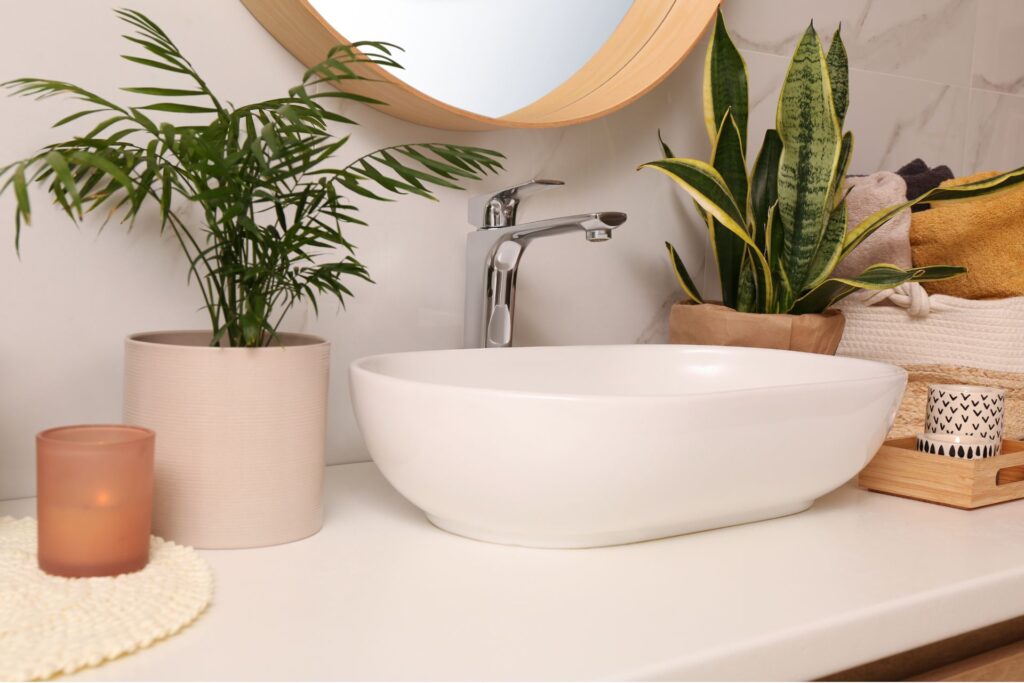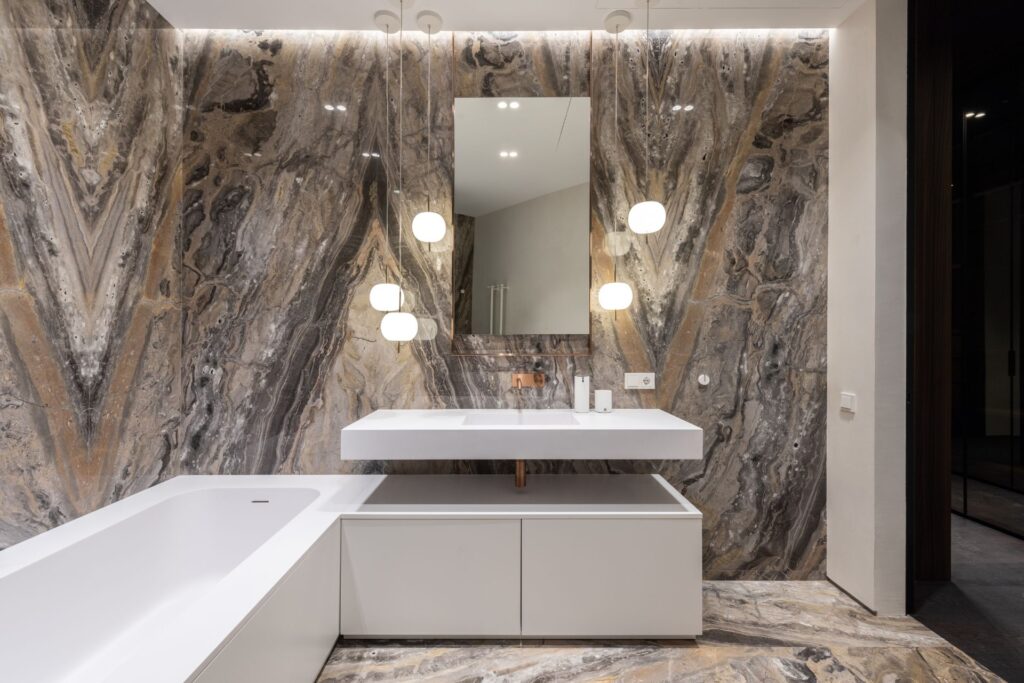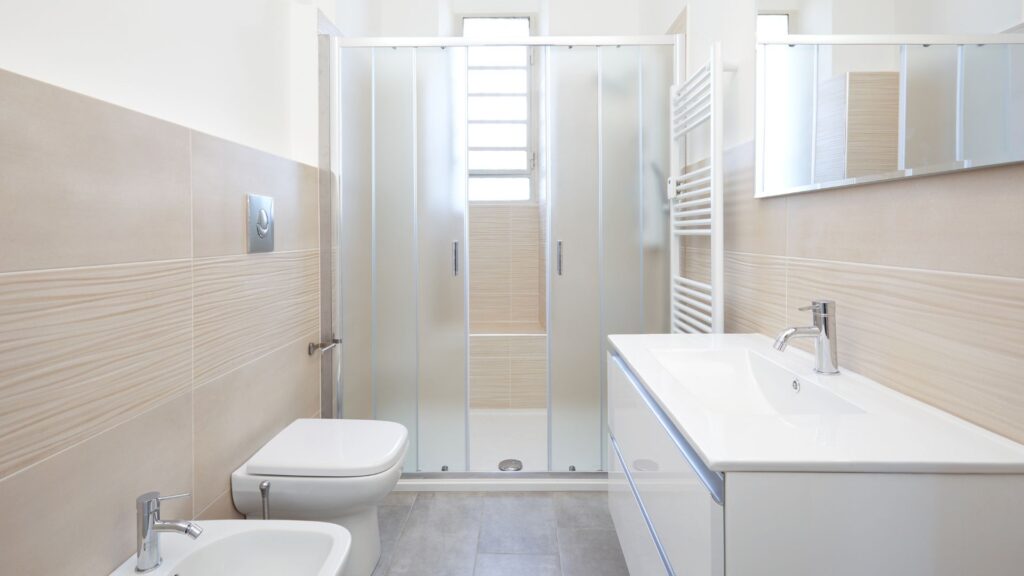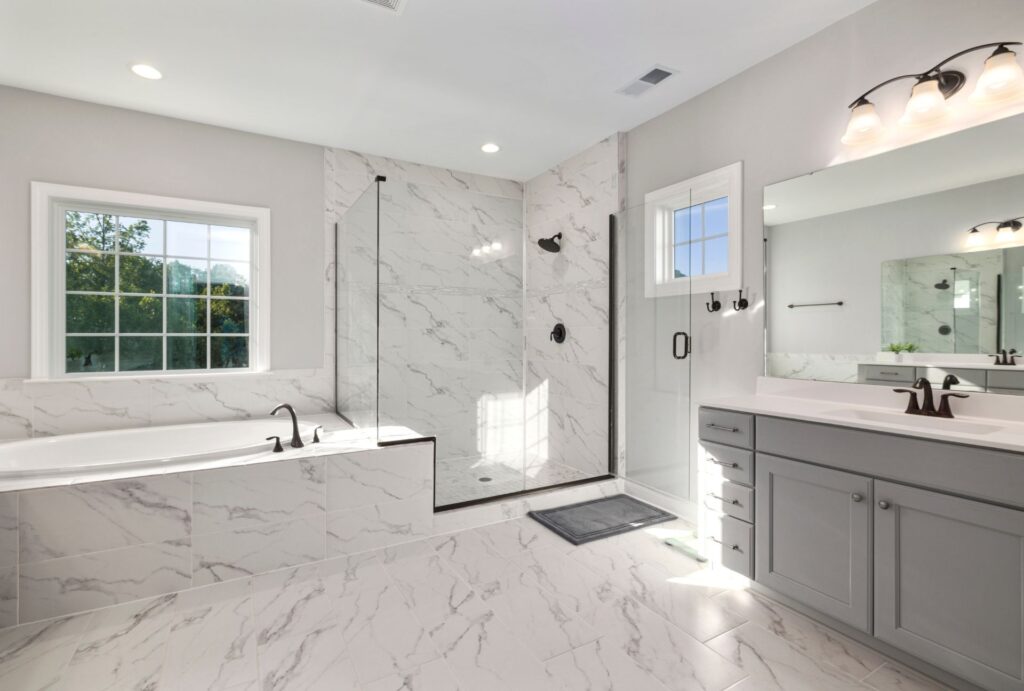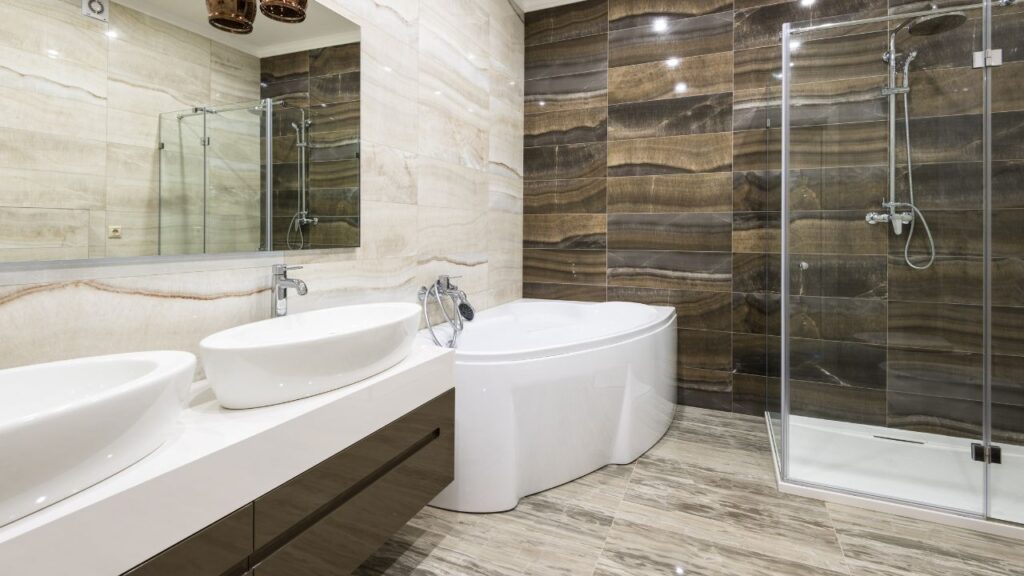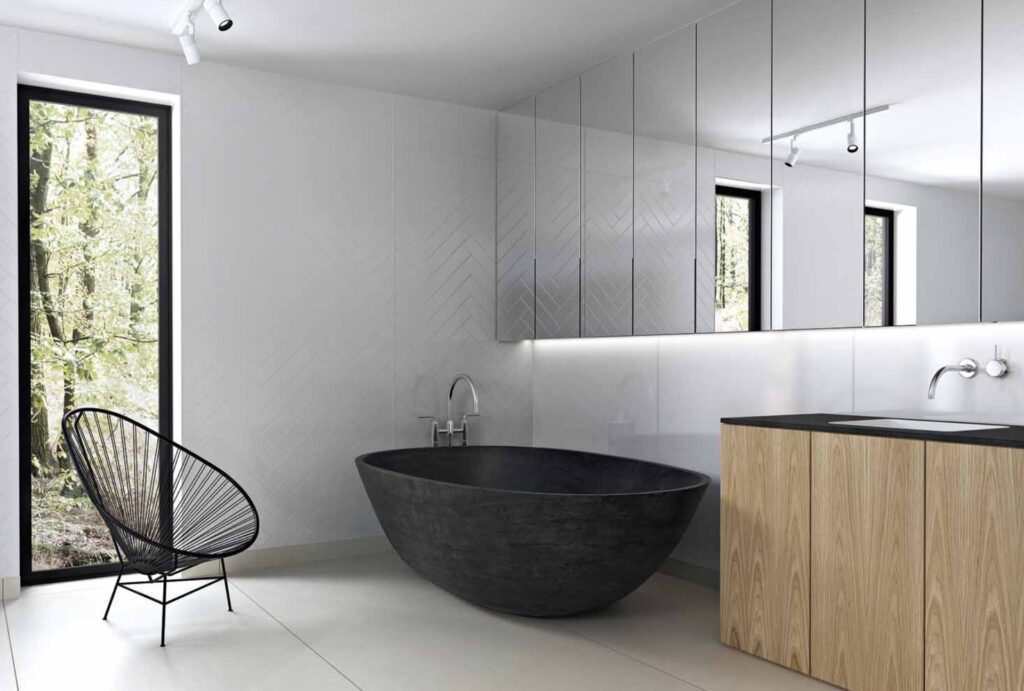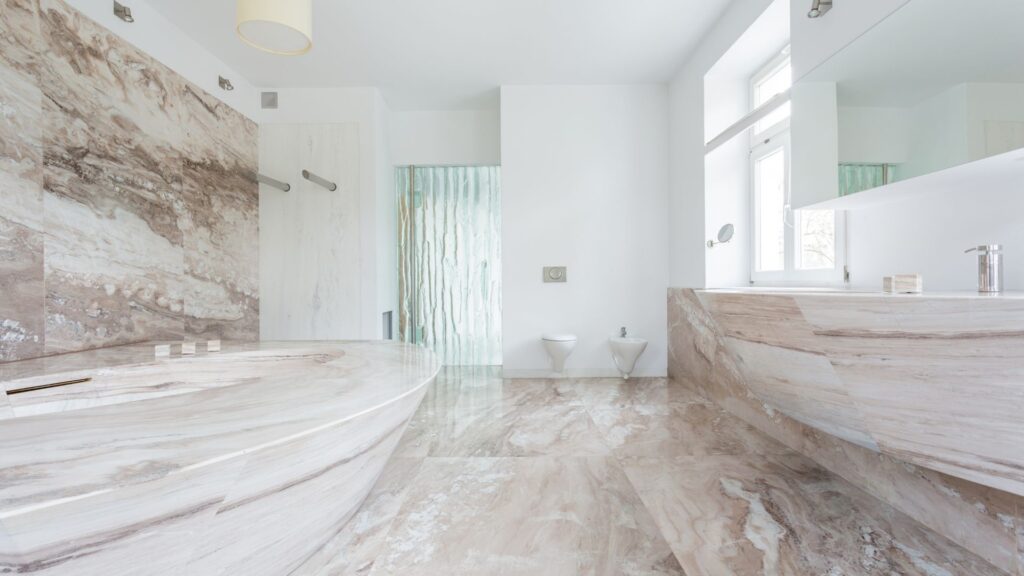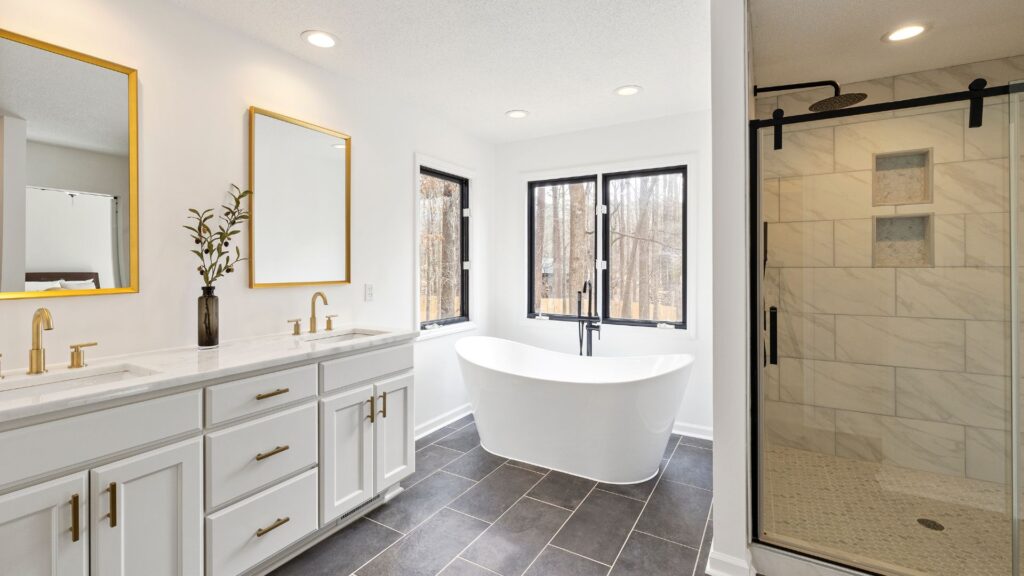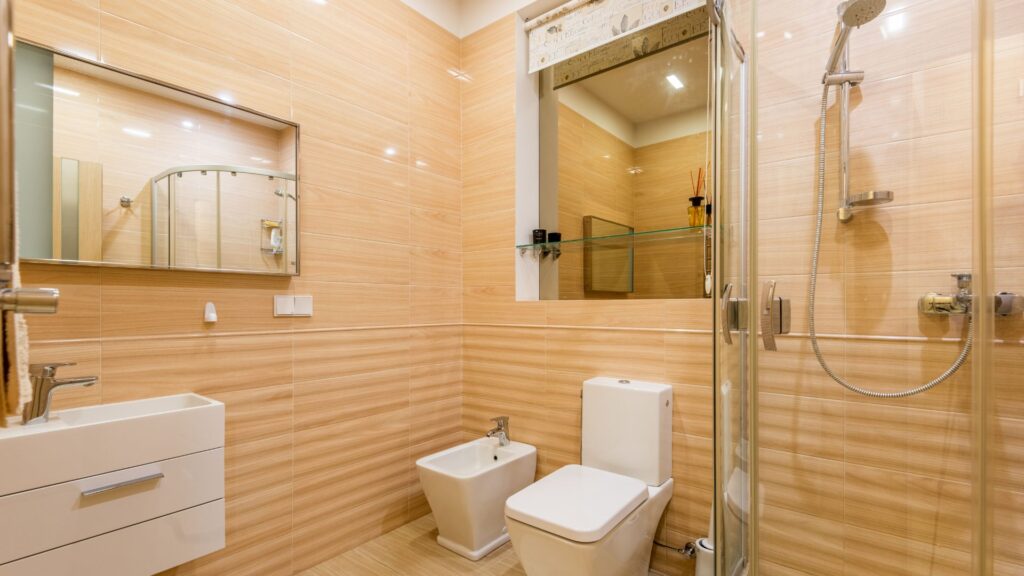Welcome to your ultimate guide on the best plants for bathrooms in New Zealand! If you’re looking to freshen up your bathroom space with a touch of greenery, you’ve come to the right place. Plants not only enhance the aesthetic appeal of your bathroom but also improve air quality and create a calming atmosphere. Whether you’re dealing with low light, high humidity, or limited space, we’ve got the perfect plant suggestions tailored to New Zealand’s unique climate and conditions. Let’s dive into the world of bathroom plants and discover how you can transform your bathroom into a lush, inviting retreat.
The best plants for bathrooms in New Zealand include peace lilies, spider plants, Boston ferns, and aloe vera. These plants thrive in the humid, low-light conditions common in bathrooms and add a fresh, natural aesthetic. Popular choices like snake plants and orchids are also ideal, offering low-maintenance options that purify the air and enhance your space with vibrant greenery.
- Why Plants Thrive In Bathrooms
- Key Considerations When Choosing Bathroom Plants In NZ
- Top 10 Best Plants For Bathrooms In New Zealand
- Popular Plant Styling Ideas For Bathrooms In NZ
- NZ-Specific Bathroom Plant Considerations
- How To Care For Bathroom Plants
- Common Mistakes To Avoid
- FAQs: About Best Plants For Bathroom NZ
- Conclusion
- Find A Professional Bathroom Renovators Near You!
Why Plants Thrive In Bathrooms
Humidity Benefits
Bathrooms are naturally high in humidity due to frequent showering and the use of hot water. This moisture-rich environment mimics the tropical conditions that many indoor plants crave, making the bathroom an ideal spot for species like ferns, orchids, and peace lilies. These plants thrive on the extra moisture in the air, which helps them maintain vibrant foliage and consistent growth. The humidity also prevents plants from drying out too quickly, reducing the need for constant watering and allowing them to flourish in a less labor-intensive manner. For plant lovers with busy schedules, placing plants in the bathroom can be a low-maintenance solution to keeping them healthy and lush.
Low Light Adaptation
Many bathrooms have limited natural light, with perhaps a small window or even no direct sunlight at all. This low-light environment is perfect for plants that are adapted to thrive in shaded conditions. Species such as snake plants, pothos, and spider plants can grow comfortably in these dimly lit spaces without suffering from a lack of sunlight. These plants have evolved to perform well under indirect lighting, making them a great match for bathrooms. So, if your bathroom lacks the brightness of other rooms, these resilient plants can still add a fresh, green touch to the space.
Air Purification
In addition to their aesthetic appeal, many bathroom-friendly plants possess air-purifying qualities that contribute to a healthier indoor environment. Plants such as aloe vera, bamboo palm, and Boston fern are known to help filter out harmful toxins, including formaldehyde and benzene, commonly found in household cleaning products. This makes them particularly useful in bathrooms, where the combination of chemical-laden cleaners and limited ventilation can reduce air quality. Adding these plants to your bathroom not only enhances the decor but also helps purify the air, creating a fresher and more pleasant atmosphere.
By choosing the right plants that thrive in humidity, adapt to low light, and purify the air, you can transform your bathroom into a refreshing mini oasis that benefits both your home and your well-being.

Key Considerations When Choosing Bathroom Plants In NZ
When it comes to selecting the right plants for your bathroom in New Zealand, there are a few crucial factors to keep in mind to ensure your greenery thrives in such a unique environment. Let’s break down some of the key considerations to help you make the best choices for your space.
Light Conditions
One of the most important things to consider when choosing bathroom plants is the lighting situation. Bathrooms can vary greatly in terms of light exposure. Some may have large windows that let in plenty of natural light, while others might rely solely on artificial lighting.
Natural light is always beneficial for plant growth, but it’s essential to evaluate how much your bathroom gets. If your bathroom enjoys lots of direct sunlight, you’ll have more flexibility with the types of plants you can choose. However, for those darker bathrooms with limited natural light, you’ll want to opt for plants that can thrive in low-light conditions, such as ferns or peace lilies.
If your bathroom relies on artificial light, you can still make it work by choosing low-maintenance plants like snake plants or ZZ plants that can survive under fluorescent lighting. You might also consider adding a grow light to supplement the lighting needs of your plants.
Temperature Variations
Bathrooms in New Zealand can experience significant temperature fluctuations due to showers and baths. The constant changes in humidity and warmth can be a little challenging for some plants to adapt to. However, certain plants are naturally resilient to these temperature shifts.
When choosing bathroom plants, look for species that can tolerate fluctuating temperatures. Tropicals like spider plants, orchids, and bamboo thrive in humid, warm environments, making them ideal choices. These plants are used to similar conditions in their natural habitats, so they won’t be fazed by the occasional blast of hot steam.
That said, it’s important to avoid plants that are sensitive to sudden drops in temperature, especially if your bathroom gets cold when not in use. Delicate plants like succulents may struggle in this setting, as they prefer stable, dry conditions.
Size and Space
Bathrooms often have limited space, and you need to choose plants that fit within the constraints of your room. Take note of how much surface area you have, whether it’s shelves, countertops, or floor space. For small bathrooms, it’s a good idea to focus on compact plants that can sit comfortably on a shelf or windowsill without taking up too much space. Hanging plants like pothos or trailing ivy can also be a great option for smaller spaces, adding greenery without cluttering up the countertops.
In larger bathrooms, you might have room for statement plants that can sit in floor pots. Consider adding a tall plant like a fiddle leaf fig or a large monstera to make a bold impact. Just make sure the plant you choose has enough space to spread out as it grows.
The key here is to match the plant size to the available space in your bathroom. Overcrowding your space with plants can make the room feel smaller and cramped, so balance is essential.
Moisture Tolerance
Bathrooms are naturally moist environments, with high humidity levels from showers and baths. While this moisture can be great for certain plants, not all greenery will enjoy such a damp atmosphere. Moisture-loving plants like ferns, air plants, and certain types of moss can actually thrive in these conditions. These plants are accustomed to absorbing water through the air, which means they’ll benefit from the humidity in your bathroom.
However, plants that prefer dry, arid environments, such as cacti or succulents, may struggle with too much moisture. These plants are better suited for other areas of your home, where the air is drier and more consistent. For moisture-tolerant plants, keep in mind that you’ll still need to manage water levels carefully. Ensure your pots have good drainage to prevent water from pooling and causing root rot.
By considering light conditions, temperature variations, available space, and moisture tolerance, you’ll be able to create a vibrant and healthy bathroom garden that brings life to your daily routine. Each of these factors plays a crucial role in determining the success of your bathroom plants, so be sure to match your plant choices to your specific bathroom environment.
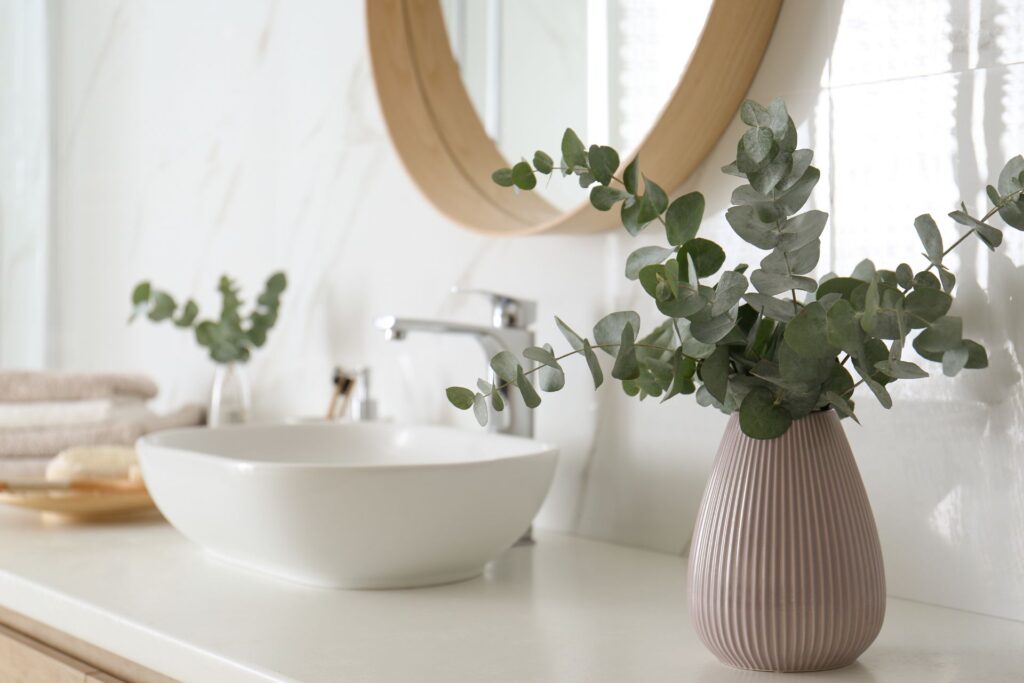
Top 10 Best Plants For Bathrooms In New Zealand
Introducing plants to your bathroom can elevate the ambiance while improving air quality. In New Zealand, bathrooms tend to be humid and have fluctuating light levels, making it essential to choose plants that thrive in these specific conditions. The following top 10 plants are well-suited for New Zealand’s climate and typical bathroom environments, balancing aesthetics with low-maintenance care.
Peace Lily (Spathiphyllum)
- Why It’s Great: The Peace Lily is a popular bathroom plant due to its tolerance for low light and its love for humidity, a perfect match for New Zealand’s bathroom climate. This plant is not only visually striking but also functions as a natural air purifier, removing toxins like mold spores from the air.
- Care Tips: Keep the soil moist but avoid letting the plant sit in water. Peace Lilies thrive on regular misting, especially in dry periods. Wipe the leaves occasionally to remove dust, ensuring that the plant can efficiently carry out photosynthesis.
Spider Plant (Chlorophytum comosum)
- Why It’s Great: The Spider Plant is resilient and versatile, making it an ideal choice for bathroom environments that may fluctuate in light and moisture. It’s also well-known for its air-purifying properties, helping to cleanse the air of formaldehyde and other chemicals.
- Care Tips: Allow the soil to dry out slightly between waterings, as Spider Plants don’t like soggy roots. Trim away dead leaves to maintain a fresh appearance, and position the plant where it will receive moderate, indirect light.
Boston Fern (Nephrolepis exaltata)
- Why It’s Great: Known for its lush, feathery fronds, the Boston Fern thrives in humid environments, making it a great bathroom addition in New Zealand. Its vibrant greenery adds life to any space while also helping to improve air quality.
- Care Tips: Keep the soil consistently moist and mist the plant regularly to mimic the tropical environments that Boston Ferns love. Position in a spot with indirect sunlight, and occasionally feed with a diluted liquid fertilizer during growing seasons.
Aloe Vera
- Why It’s Great: Aloe Vera is not just a beautiful addition to your bathroom; it’s also highly functional with its skin-soothing properties. This succulent is incredibly hardy and thrives even with minimal light, making it perfect for less sun-filled bathrooms.
- Care Tips: Aloe Vera prefers well-draining soil and should be watered sparingly, allowing the soil to dry out completely between waterings. Place the plant near a window for indirect light to ensure it remains healthy and vibrant.
Bamboo
- Why It’s Great: Bamboo plants are a fantastic option for bathrooms because they require minimal sunlight and can grow well in water. Their tall, slender stalks add a calming, zen-like atmosphere to any space, aligning well with modern bathroom aesthetics.
- Care Tips: Bamboo needs to be submerged in water to grow effectively. Change the water every two weeks to prevent stagnation, and ensure that the plant has access to moderate indirect light to keep it thriving.
Orchids (Phalaenopsis)
- Why It’s Great: The elegance and grace of Orchids make them a perfect fit for bathrooms, where their delicate flowers can thrive in warm, humid conditions. They bring a touch of luxury and style to your bathroom, elevating the space.
- Care Tips: Orchids prefer bright, indirect light and regular misting to simulate the humid environments they originate from. Ensure the plant remains in well-draining soil, and water it lightly to avoid root rot.
Pothos (Epipremnum aureum)
- Why It’s Great: Pothos is a popular choice for bathrooms due to its adaptability to low light and irregular watering schedules. This trailing plant looks stunning in hanging baskets, adding greenery without taking up valuable counter space.
- Care Tips: Pothos prefer their soil to dry out between waterings. Prune the vines regularly to keep them looking tidy and manage their length as they can grow quickly in the right conditions.
ZZ Plant (Zamioculcas zamiifolia)
- Why It’s Great: The ZZ Plant is incredibly low-maintenance, making it ideal for bathrooms that may not always receive natural light. It tolerates low light and moisture, making it an easy-care option for busy households.
- Care Tips: Water the ZZ Plant sparingly, allowing the soil to dry completely between waterings. Wipe the glossy leaves regularly to keep them free of dust and looking their best.
Snake Plant (Sansevieria trifasciata)
- Why It’s Great: Known for its hardy nature, the Snake Plant can survive in low light and humid conditions. It’s also an excellent air purifier, helping to remove toxins and improving air quality in your bathroom.
- Care Tips: Water infrequently, as Snake Plants are prone to root rot if overwatered. Place them in indirect light for optimal growth, but they will also tolerate low-light environments, making them very versatile.
Asparagus Fern
Why It’s Great: Asparagus Ferns add a soft, delicate touch to any bathroom with their feathery, arching fronds. They love humidity and indirect light, making them a perfect match for bathrooms in New Zealand.
- Care Tips: Keep the soil moist and place the fern in a location where it can enjoy indirect sunlight. Mist frequently to maintain humidity and prevent the plant from drying out.
These plants not only enhance the aesthetic of your bathroom but also offer numerous health benefits, such as air purification and stress reduction. By choosing plants that thrive in New Zealand’s unique climate and your bathroom’s specific conditions, you can create a green, refreshing space that’s both beautiful and functional.

Popular Plant Styling Ideas For Bathrooms In NZ
Transforming your bathroom into a relaxing, nature-inspired space is easy with the right plant styling. Here are some creative ways to incorporate greenery into your bathroom design in New Zealand, ensuring your space remains both stylish and functional.
Hanging Plants
One of the most popular ways to introduce plants into the bathroom without taking up valuable floor or counter space is by using hanging plants. Opt for hanging baskets or wall-mounted planters to create a vertical garden effect. Plants like spider plants, ivy, or pothos thrive in low light and high humidity, making them perfect for bathroom environments. The cascading effect of hanging plants adds a touch of softness to otherwise hard surfaces, such as tiles and mirrors. Additionally, their placement draws the eye upward, creating the illusion of a more spacious room. This technique not only saves space but also injects life and energy into the bathroom.
Window Shelves
Bathrooms in New Zealand often have small windows, which can sometimes limit natural light. However, window shelves provide a perfect opportunity to display small pots of greenery along the windowsill. Succulents, small ferns, or even miniature orchids can thrive here, benefiting from the natural light that streams through. This setup not only brightens the room but also adds a fresh, airy vibe to the space. The addition of plants on window shelves makes the bathroom feel more connected to the outdoors while offering a calming visual element to those who use the space. Just be sure to choose plants that can handle the occasional moisture and temperature fluctuations common in bathrooms.
Shower Plants
If your bathroom features a shower with ample light, consider adding plants that love moisture and humidity directly into the shower area. Tropical plants like ferns, peace lilies, and air plants thrive in these conditions. By positioning them near the shower, you’re providing an environment that mimics their natural habitat—warm, humid, and with indirect light. Hanging small pots or installing a plant shelf just outside the shower is an excellent way to incorporate greenery without it being in the way. Not only do these plants benefit from the constant humidity, but they also contribute to the overall spa-like atmosphere, making your bathroom feel like a mini-retreat.
Corner Pots
Bathrooms often have awkward, unused corners that can feel empty or underutilized. Filling these spaces with medium-sized potted plants is an effective way to incorporate greenery without adding clutter. Larger plants like snake plants, rubber plants, or even bamboo thrive in bathroom corners, where they can add height and texture to the room. These plants are also typically low-maintenance and can tolerate the less-than-ideal light conditions found in many bathrooms. Corner pots bring a sense of balance to the space, offering a natural focal point while softening the overall design.
Incorporating these popular plant styling ideas into your bathroom in New Zealand can create a calming and inviting environment. Each approach—from hanging plants to corner pots—allows you to bring the beauty of nature indoors, enhancing your bathroom’s aesthetic and your overall well-being.

NZ-Specific Bathroom Plant Considerations
When selecting plants for your bathroom in New Zealand, it’s essential to keep the local climate and environmental factors in mind. From varying regional climates to sustainable plant care, these considerations will ensure that your bathroom plants not only survive but thrive.
Climate Differences: Adapting to North and South Island Conditions
New Zealand’s climate can vary significantly between the North and South Islands, which will influence the type of plants that will do well in your bathroom. The North Island generally has a warmer, subtropical climate with higher humidity, which is ideal for plants like ferns, orchids, and peace lilies. These plants love moist environments and can thrive in a steamy bathroom with proper care.
On the other hand, the South Island experiences cooler temperatures and lower humidity levels, particularly in the southern regions. This climate might be less forgiving for tropical plants, but you can still successfully grow heartier indoor varieties such as spider plants, pothos, and certain succulents. These species are more tolerant of temperature fluctuations and lower humidity, making them better suited to the cooler South Island conditions.
Understanding your region’s specific climate is crucial in choosing the right plants. You can also adjust the conditions within your bathroom by incorporating a humidifier in cooler, drier climates, or providing proper ventilation in warmer, more humid environments to prevent mold and rot.
Sourcing Plants Locally: Support Your Local NZ Nurseries
One of the best ways to ensure that your bathroom plants are healthy and resilient is by sourcing them locally. New Zealand has a rich horticultural industry, with numerous nurseries and garden centers offering a wide variety of native and exotic plants that are well-adapted to the local environment.
By purchasing plants from local nurseries, you’re not only supporting your community but also ensuring that you’re getting plants that are already accustomed to New Zealand’s climate and conditions. Locally grown plants have been raised in similar weather patterns, reducing the shock of transplantation and increasing their chances of success in your bathroom. Plus, local nurseries often offer expert advice on plant care, helping you make informed decisions about which plants will thrive in your bathroom’s unique environment.
Additionally, buying locally reduces the carbon footprint associated with long-distance shipping and helps preserve New Zealand’s biodiversity by promoting native species. Look for plants that are grown organically and ask your local nursery about sustainable gardening practices to ensure you’re making eco-friendly choices.
Eco-Friendly Plant Care: Sustainable Practices for Bathroom Plants
Caring for bathroom plants sustainably is a great way to ensure your green choices have a minimal environmental impact. Start by practicing water conservation. Since bathrooms already have high moisture levels, your plants may not need as much water as those in other parts of your home. Use water wisely by placing your plants in spots where they can naturally absorb steam from showers, which can reduce the need for additional watering.
Another key to eco-friendly plant care is using organic fertilizers. Avoid chemical-based fertilizers that can be harmful to the environment and instead opt for natural alternatives like compost, worm castings, or seaweed-based fertilizers. These options are not only better for your plants but also safer for your home and the environment.
When repotting your plants, consider using biodegradable pots or recycled materials to reduce plastic waste. Choose potting soil that’s sourced responsibly, avoiding those that contribute to deforestation or depletion of natural peat bogs. Look for locally produced, organic potting mixes that are rich in nutrients and tailored for indoor plants.
Finally, always be mindful of the energy you use in your bathroom. Incorporating more natural light through windows or skylights will reduce your reliance on artificial lighting, which is beneficial for both your plants and your energy bill. If natural light is limited, choose energy-efficient grow lights that mimic sunlight without consuming too much power.
By paying attention to these NZ-specific bathroom plant considerations—such as climate, local sourcing, and sustainable care—you can create a lush, vibrant space that thrives in harmony with New Zealand’s unique environment.
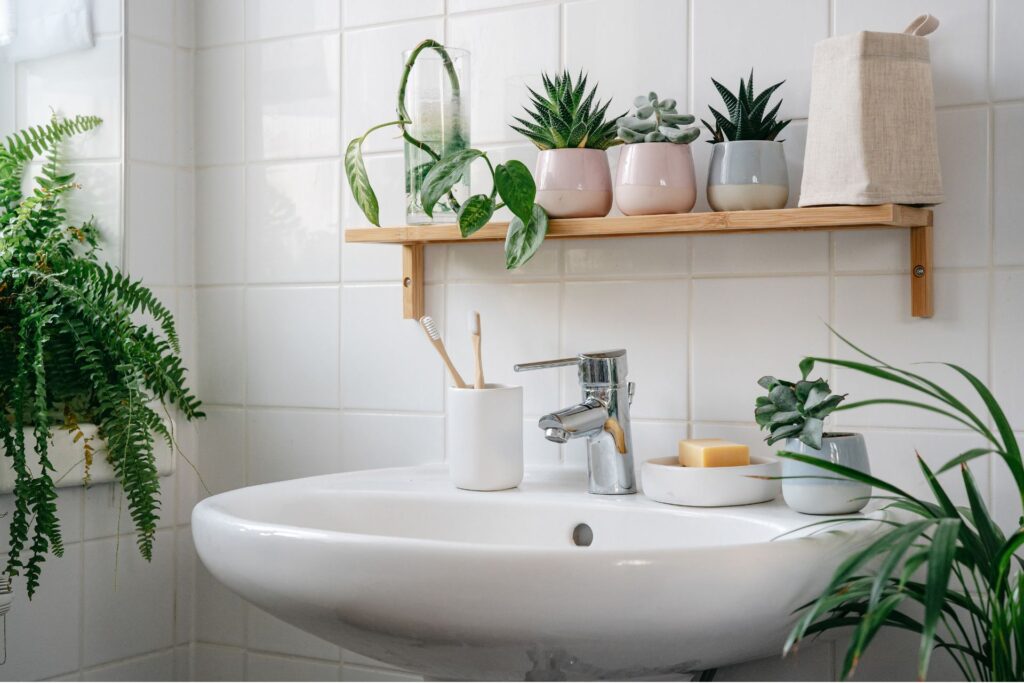
How To Care For Bathroom Plants
Caring for bathroom plants requires thoughtful attention, given the unique conditions of a bathroom environment. The combination of fluctuating humidity, low light, and moisture makes it crucial to adapt traditional plant care routines for success.
Watering Tips
Balancing bathroom humidity with an appropriate watering schedule can be tricky but is essential for keeping plants healthy. Bathrooms tend to have higher humidity levels due to showers and baths, which can mean less frequent watering is needed for most plants. However, it’s important not to assume that bathroom humidity alone is enough.
Instead, assess the soil’s moisture levels regularly by sticking your finger about an inch into the soil. If it feels dry at that depth, it’s time to water. Overwatering can lead to root rot, especially in a damp bathroom environment, so it’s better to err on the side of caution. Plants like ferns and orchids thrive in these conditions and may only need watering every 7-10 days, while succulents might require less frequent attention. Always water directly at the base of the plant to avoid mold or mildew forming on the leaves due to moisture.
Fertilizing
Fertilizing bathroom plants can enhance their growth, but overdoing it in a humid environment can lead to burnt leaves or stunted growth. For bathroom plants, slow-release fertilizers are ideal as they provide consistent nutrients over time without overwhelming the plant. These fertilizers gradually break down with each watering, supplying a steady nutrient stream for months.
It’s best to apply slow-release fertilizer every 2-3 months during the plant’s growing season, which typically runs from spring through early fall. Be cautious during the winter months, as plants grow slower and need less feeding. If you prefer liquid fertilizer, dilute it to half the recommended strength to avoid over-fertilizing, especially in the confined bathroom space.
Pest Prevention
Bathrooms, being damp and warm, can create a breeding ground for pests like fungus gnats, mealybugs, and spider mites. To keep your bathroom plants pest-free, it’s essential to maintain good airflow and regularly inspect your plants for any signs of infestation. Remove any dead or decaying plant material, as this can attract pests, and ensure that water isn’t pooling at the base of pots.
Natural remedies, such as neem oil or insecticidal soap, are effective for keeping pests at bay. These treatments are safe for bathroom use and won’t harm your plants. If you spot pests, isolate the affected plant and treat it immediately, following up every few days until the infestation is under control. As a preventative measure, you can spray your plants with neem oil every few weeks during warmer months when pests are most active.
By following these care guidelines, your bathroom plants will stay healthy and vibrant, thriving in the unique microclimate of your bathroom.
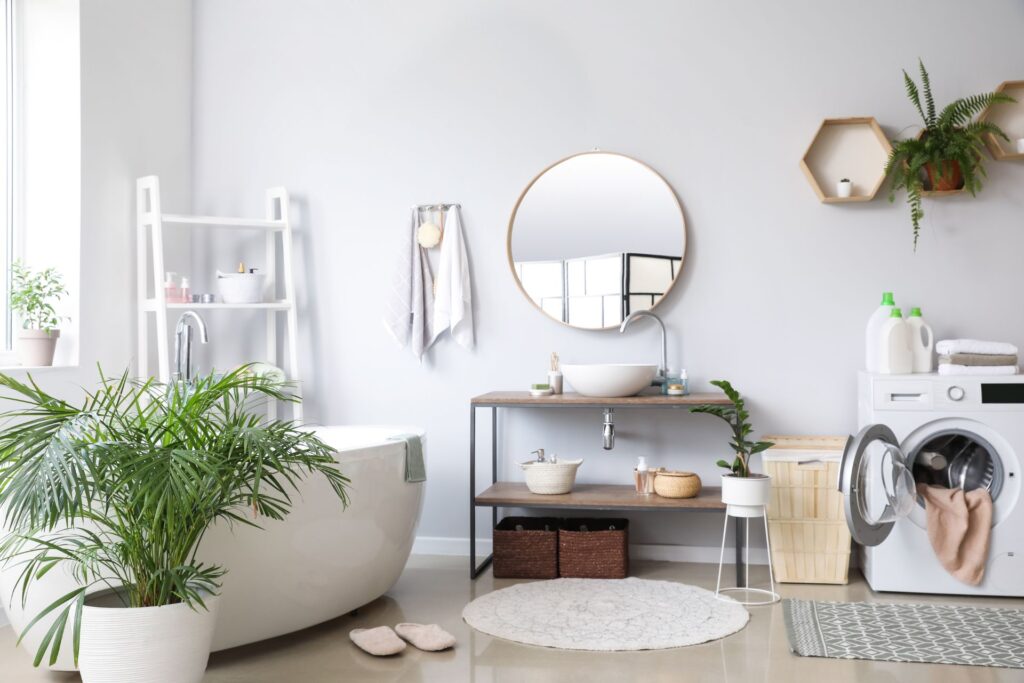
Common Mistakes To Avoid
Overwatering
One of the most common mistakes when caring for bathroom plants is overwatering. Bathrooms, particularly humid ones, provide a moist environment that can cause plants to absorb water from the air, reducing the need for frequent watering. Many plant owners, however, mistakenly think that more water equals better growth. Unfortunately, this can lead to root rot, fungal growth, and wilting leaves. Always check the soil before watering. If it’s still moist to the touch, hold off on adding more water. It’s important to strike the right balance—keeping the plant hydrated without drowning it.
Placing Plants in Direct Sunlight
While some plants thrive in bright light, placing them directly in sunlight—especially through bathroom windows—can do more harm than good. The glass may amplify the sun’s rays, causing leaves to burn or dry out. Bathroom plants often thrive in indirect light or low-light conditions, making them perfect for shaded corners or spaces away from direct exposure. Before placing a plant on a windowsill, check the light needs of the specific species. A little research goes a long way in ensuring your plants stay lush and healthy.
Neglecting Pruning
Just because a plant is surviving in your bathroom doesn’t mean it doesn’t need regular attention. Pruning is vital to a plant’s health, helping to remove dead or dying leaves and encouraging new growth. Neglecting this step can lead to leggy, unattractive plants and even slow their growth. Trimming back overgrown sections and removing damaged parts will keep your bathroom plants looking vibrant and fresh. It’s also a chance to inspect your plants for pests or diseases, ensuring they continue to flourish in their environment.
Avoiding these common mistakes will ensure your bathroom plants not only survive but thrive, adding natural beauty to your space.
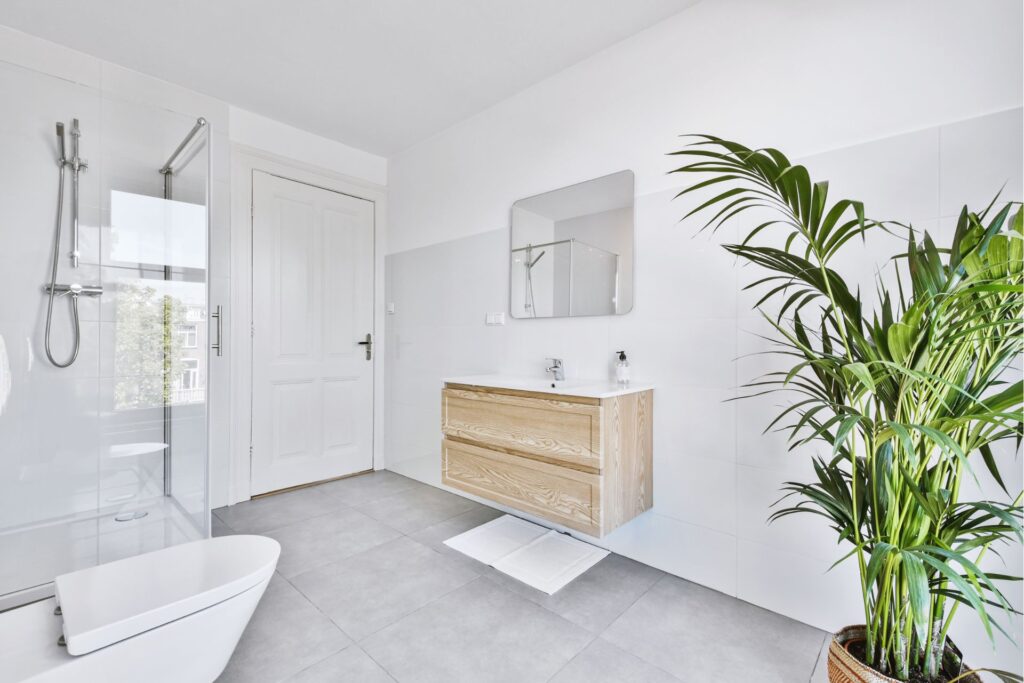
FAQs: About Best Plants For Bathroom NZ
Conclusion
In conclusion, adding plants to bathrooms not only enhances the aesthetic appeal but also improves air quality and creates a calming atmosphere, making your bathroom feel like a personal spa retreat. Popular plant choices for New Zealand homes, such as ferns, spider plants, and orchids, thrive in the humidity of bathroom environments, offering a touch of nature even in small spaces. Don’t hesitate to experiment with different plant placements and varieties to see what works best in your specific bathroom setting—whether it’s a hanging plant near the shower or a potted plant on a windowsill. If you’re ready to elevate your bathroom with greenery, why not start today by visiting your local garden center or browsing online to find the perfect plants to begin your journey?
Find A Professional Bathroom Renovators Near You!
- Bathroom Renovations Alexandra
- Bathroom Renovations Alexandra, Clyde & Cromwell
- Bathroom Renovations Auckland
- Bathroom Renovations Cambridge
- Bathroom Renovations Central Otago
- Bathroom Renovations Christchurch
- Bathroom Renovations Clyde
- Bathroom Renovations Cromwell
- Bathroom Renovations East Auckland
- Bathroom Renovations Hamilton
- Bathroom Renovations Hastings
- Bathroom Renovations Hawkes Bay
- Bathroom Renovations Invercargill
- Bathroom Renovations Kapiti Coast
- Bathroom Renovations Levin
- Bathroom Renovations Lower Hutt
- Bathroom Renovations Napier
- Bathroom Renovations Nelson
- Bathroom Renovations New Plymouth
- Bathroom Renovations North Shore
- Bathroom Renovations Palmerston North
- Bathroom Renovations Porirua
- Bathroom Renovations Queenstown
- Bathroom Renovations South Auckland
- Bathroom Renovations Te Awamutu
- Bathroom Renovations Upper Hutt
- Bathroom Renovations Wanaka
- Bathroom Renovations Warkworth
- Bathroom Renovations Wellington
- Bathroom Renovations West Auckland
- Bathroom Renovations Kerikeri
- Bathroom Renovations Paihia
- Bathroom Renovations Tauranga
About the Author:
Mike Veail is a recognized digital marketing expert with over 6 years of experience in helping tradespeople and small businesses thrive online. A former quantity surveyor, Mike combines deep industry knowledge with hands-on expertise in SEO and Google Ads. His marketing strategies are tailored to the specific needs of the trades sector, helping businesses increase visibility and generate more leads through proven, ethical methods.
Mike has successfully partnered with numerous companies, establishing a track record of delivering measurable results. His work has been featured across various platforms that showcase his expertise in lead generation and online marketing for the trades sector.
Learn more about Mike's experience and services at https://theleadguy.online or follow him on social media:

